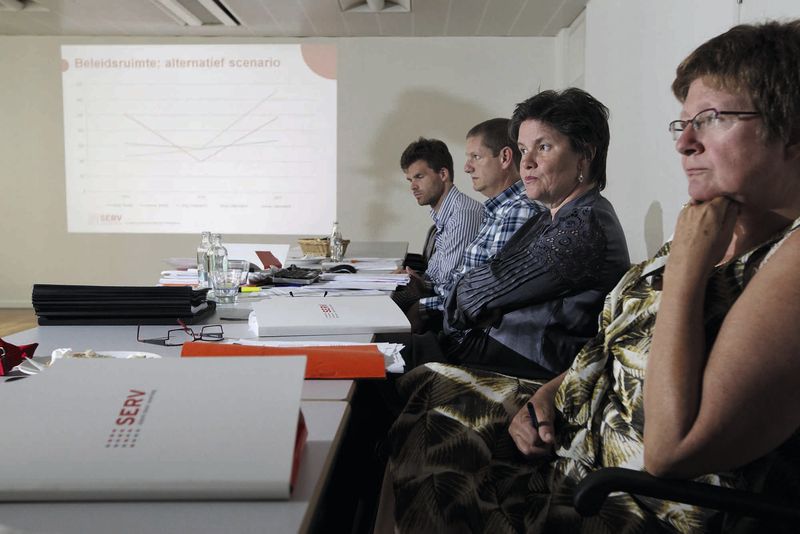
Opening of the Social Pact, 1944 | Brussels, National Archives of Belgium, archief VBO 1394
The Social Pact
Social Security and the Welfare State
On 20 April 1944, while the war was still raging, a number of trades union leaders and employers signed the ‘Preliminary Draft Declaration on Social Solidarity’. The proposals in that document, better known as the Social Pact, brought about a radical change in society.
Before 1940 employees had limited social protection. Trades unions and employers’ organisations could not agree on its extent. But the compulsory measures of the Nazi occupier and the radicalisation of the workers’ movement during the war brought them closer together.
In 1941 a few employers and heads of trades unions started negotiating. The result was the Social Pact. In it they agreed to set up a permanent consultation system between trades unions and employers’ organisations, and to build up a strong system of social security.
After the liberation the Socialist Minister of Labour and Social Affairs did not let the grass grow under his feet. On the basis of the agreement reached he drafted a bill introducing social security. In the following decades the Social Pact acquired an almost mythical status, as the foundation of the welfare stateafter English welfare: supplementary payments. .

Ghent, Amsab-ISG, fo003470
Women workers block the factory gate of the sewing yarn factory Filature et Filteries Réunies in Aalst during the general strike of 1936. By withholding their labour for weeks on end, employees were able to force employers to concede, for example, one week’s paid leave.
Social Security and the Welfare State
At the end of the 19th century, thanks to the struggle of the workers’ movement the first forms of social protection emerged. Unemployment funds, health insurance and pension funds had to insure workers against unemployment, sickness and old age. They were mostly voluntary insurance schemes and employers seldom contributed. The initiatives did, however, often enjoy the support of local or national government.
During the Great Depression of the 1930s unemployment was on a huge scale. In the West many people had a growing conviction that stronger social protection was necessary. In Belgium the Social Pact of 1944 was the springboard to help accomplish this.
Immediately after the war there was for (almost) all employees compulsory insurance against sickness, injury and unemployment, together with systems for pensions and child benefit. Both employees and employers paid contributions towards these. The government controlled and subsidised the system. Trades unions, health insurance schemes and child benefit funds dealt with the payments.
Social security was not perfect. The self-employed and some employees were at first excluded. Young people and women often lost out. The system was based mainly on full-time working, adult, male breadwinners. Still, social security formed the basis of the postwar welfare state.
Focal points
Discover more on this topic
Non-fiction
Wat zoudt gij zonder ‘t werkvolk zijn? De geschiedenis van de Belgische arbeidersbeweging 1830-2015
Van Halewyck, 2015.
De schaduw van het interbellum België, 1918-1939
Lannoo, 2017.
De christelijke arbeidersbeweging in België
2 dln., UPL, 1991.
Het Sociaal Pact van 1944. Oorsprong, betekenis en gevolgen
VUBPress 1995.
Het Sociaal Pact van 20 april 1944: kanttekeningen bij een politieke tekst
Brood & Rozen, 2015, 4, p.26-49.
Sociaal-economisch overleg in België sedert 1918
VUBPress, 1995.
Een geschiedenis van het sociaaleconomisch overleg in Vlaanderen (1945-2010). 25 Jaar SERV
Academia Press, 2010.
Wij zijn de AC: 100 jaar Algemene Centrale ABVV, 200 jaar syndicale geschiedenis
AMSAB, 2008.
De beginjaren van de sociale zekerheid in België, 1944-1963
VUB Press, 2014.
In naam van de sociale vooruitgang: de rol van de overheid in het sociaal overleg in België (1944-1981)
Acco, 2007.
Fiction
Groenten uit Balen
De Bezige Bij, 1972.
Het koekoeksjong
Kritak, 1995.
Moeder, waarom leven wij?
Houtekiet, 1999.









